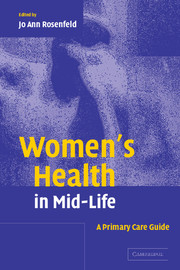1 - Introduction
Published online by Cambridge University Press: 21 August 2009
Summary
The middle ages of women are an often forgotten time and the women are often overlooked in healthcare. No longer in their childbearing and birth control years, and not yet geriatric, the women are frequently ignored or their needs and wishes combined into one homogeneous group. Regularly, healthcare providers address only the women's hormonal needs and minimize discussion of their health and wellbeing. These women, who are from the ages of 40 to 65, are in a variety of situations and circumstances, both medical and social. These ages are a time of change, stress, and opportunity.
Despite the fact that there are more women than men at every age, this time of change is poorly studied and understood for women (Figure 1.1). Many large population studies have not included women, have included only a few women, or have not reported data by gender. Few studies have examined this age group. The change to adolescence, adulthood, and elder has been well examined and researched. Each of these ages has their own specialists (obstetrician/gynecologist or geriatrician). However, the middle ages are often neglected. Menopause is not a disease, a definite time, or a curse. Its needs, challenges, and effects on women's health are not understood well. Familial and social stresses may be challenging or overpowering, as the woman has to redefine herself within society, employment, and her family.
The opportunities for improvement for future health are immense. Women can make lifestyle changes that will profoundly affect their future health, comfort, and length of life.
Keywords
- Type
- Chapter
- Information
- Women's Health in Mid-LifeA Primary Care Guide, pp. 1 - 4Publisher: Cambridge University PressPrint publication year: 2004
References
- 2
- Cited by



